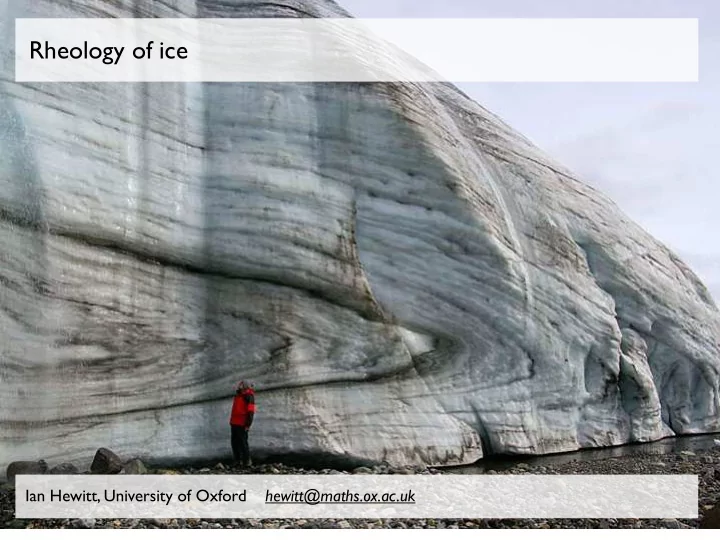

Rheology of ice Ian Hewitt, University of Oxford hewitt@maths.ox.ac.uk
Constitutive law - Stress and strain rate - Glen’s law Microscopic view - Crystal structure - Fabric - Deformation mechanisms Macroscopic view - More general flow laws - Effect of temperature and water content - Visco-elasticity
Constitutive law Rheology is the study of how materials flow. We seek a constitutive law or flow law to relate stress and strain rate. stress = force per unit area strain rate = normalised stretching rate τ ε ˙ The general form is a tensorial relationship ✓ ∂ u i ◆ + ∂ u j ε ij = 1 deviatoric stress tensor strain rate tensor τ ij = 2 ˙ ∂ x j ∂ x i 2 ✓ e.g. Newtonian fluid τ ij = 2 η ˙ ε ij ✓ ◆ ✓ More generally τ ij = c ijkl ˙ ε kl ✓ is an effective viscosity tensor (4th order - 36 components) that may depend on c ijkl invariants of the stress tensor, temperature, grain size, fabric, impurities, …. If the ice is assumed to be isotropic, with stress and strain rate aligned ε ij = λτ ij ˙
Example modes of deformation Uni-axial compression F Simple shear τ = F F = A τ = F A A = A L d L ε = 1 L ˙ ε = u L d t ˙ L Time Time
Example strain regimes in Antarctica 110 Law Dome Strain Regime Law Dome Flow Regime (c] 1.4 (a) ~in d ..... ,~*, t 5---":L_[ >, 10- (b) -1.0 E E 0 o <~ O O ........ . . o 0 "'- 0 < 4'0 s'o 8'0 16o 20 40 60 80 100 0 Distance, km Distance, km Fig. 1. Law Dome flow and strain regimes. The cross-sections of Law Dome from the summit to Cape Folger are shown with Budd & Jacka 1989 surface and bedrock from echo-sounding (to 0.25 km resolution). (a) The computed particle paths (full curves) are shown with the ages (dashed lines in ka). The position ofboreholes are indicated I.SGD; 2.BHD; 3.Q; 4.B; 5.P; 6.F; 7.A; 8.BHCI; 9.BHC2. (b) The smooth horizontal surface velocity V (ma-L ) and the average accumulation rate A (ma ~ water) are shown from the summit to the coast. (c) The accumulated vertical compressive strain computed for the upper part of the Law Dome section for e: from 0.1 to 0.5. (d) The accumulated horizontal shear strain is shown for ~ ~: from 0.1 to 10. minimum or tertiary strain rates, cf. Russell-Head depending on the relative magnitudes of the longi- and Budd (1979), Lile (1978, 1984), Jacka tudinal and transverse strains. (1984b), Gao and Jacka (1987). It is important to By the time that about one-third of the depth is understand the properties of this initial upper ice reached, typically in the age range of 1000-2000 since it represents the starting material for the sub- years, horizontal shear starts to dominate and by sequent developments within the ice sheet. One about two-thirds of the depth there may develop a proviso for this concept is that for the old ice at zone of strong horizontal shear with a high concen- depth previous conditions (such as chemical and tration of vertical c-axes in the ice. The lower part dust content, etc.) may have been different at the of the ice sheet has a very variable stress and strain surface in the past from those which pertain at pres- rate regime as the ice flows over and around the wide ent, so this may also need to be considered. spectrum of bedrock variations. Although the basal Below this initial upper ice is a region which shows ice is relatively very old, and has accumulated large the effect of increasing vertically compressive stress strains, the highly variable stress field near the base and strain. The fabrics tend to be symmetrical about can cause the ice crystal structure to be also very the vertical with either a small circle girdle associ- variable, depending on the most recent stress and ated with uniform unconfined compression, cf. strain regime for the ice, and possibly some residual Budd (1972), a 2-maxima fabric associated with effects of prior strains. In some cases the basal ice confined compression, cf. Budd and Matsuda may be almost stagnant in low stress regions where (1974), or a state intermediate between these two large intertwined ice crystals grow with multi-max-
Glen’s law Glen’s law is the most commonly used flow law for ice in glaciers and ice sheets. ε = A τ n ˙ ✓ ≈ − A ≈ 2 . 4 × 10 � 24 Pa � 3 s � 1 0 � C Usually and at n ≈ 3 But the most appropriate values in reality may depend on temperature, stress regime, grain size, etc τ 2 = 1 2 τ ij τ ij = 1 τ 2 xx + τ 2 yy + τ 2 + τ 2 xy + τ 2 xz + τ 2 � � ε ij = A τ n � 1 τ ij In tensorial form ˙ zz yz 2 second invariant - ‘effective stress’ This can also be written as τ ij = 2 η ˙ ε ij − 1 is the effective viscosity η = 2 A τ n − 1 (In general fluid mechanics terminology Glen’s law is referred to as a ‘power-law’).
Glen’s law ✓ Slope indicates n ≈ 3 (different lines for Strain different temperatures) rate Stress Glen 1955
Recommend
More recommend